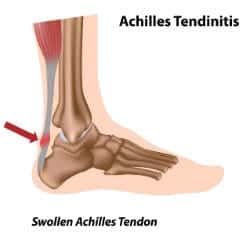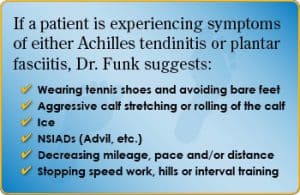Diagnosing and Treating Common Runner Injuries, Achilles Tendinitis and Plantar Fasciitis
- What Is Achilles Tendinitis?
- How Is Achilles Tendinitis Diagnosed and Treated?
- What Is Plantar Fasciitis?
- How Is Plantar Fasciitis Diagnosed and Treated?
- How Can You Treat Achilles Tendinitis and Plantar Fasciitis at Home?
Runners with heel pain should consult a foot and ankle specialist for their initial physician visit for lower extremity injuries. Diagnosing and treating the most common running injuries requires finding the cause of the injury and going beyond simply treating the symptoms.
Running injuries usually happen when you push yourself too hard. The way your body moves also plays a role. With the running season in full swing throughout Orlando, area physicians tend to see more patients complaining of foot/ankle pain and injuries.
Two of the most common running conditions seen by Foot and Ankle Center Specialists and avid runners Joseph D. Funk, D.P.M., and Daniel L. Wiernik, D.P.M., at Orlando Orthopaedic Center are Achilles tendinitis and plantar fasciitis.
What Is Achilles Tendinitis?

Achilles tendinitis
Achilles tendinitis occurs when the tendon that connects the back of the leg to the heel becomes swollen and ultimately painful near the back of the heel or leg, says Dr. Funk. It is typically diagnosed as a result of “overuse” by the runner; and it is often brought about by increasing pace, distance, frequency or speed work.
Dr. Wiernik adds that pain is usually localized directly with the tendon, but it may radiate around the entire back of the ankle. “In the early stages, runners may only feel it after their run,” he says. “As it worsens, they have pain during their run.”
If there is no swelling or bruising present, the runner is advised to work through the injury by making minor adjustments to their routine.
How Is Achilles Tendinitis Diagnosed and Treated?
If the problem persists or becomes more severe, it is suggested that physician intervention be considered. During this initial appointment, an assessment is performed to determine if the patient is genetically or chronically tight in the calf.
“Assuming there is no evidence of tear in the Achilles tendon, treatment would consist of the same at-home methods discussed earlier,” says Dr. Funk. “If it’s too painful and conservative methods fail, then boot immobilization may be considered until the tendon heals.”
If further measures must be taken, the patient is referred for an MRI to help determine the precise cause of the issue. Dr. Wiernik notes that Achilles tendinitis rarely results in any kind of surgical correction.
What Is Plantar Fasciitis?
Plantar fasciitis is an inflammation of the thick tissue on the bottom of the foot caused by microtearing (strain). Pain associated with the condition is most commonly localized to the bottom of the heel.
The most common cause of plantar fasciitis is again “overuse” by the runner as a result of rapid increases in pace, mileage, distance, speed work and plyometrics. “With the increase there is a tightness within the calf, and limited dorsiflexion through the gait pattern of walking or running,” says Dr. Funk. “This causes more pronation stress on the plantar fascia and allows the inflammatory process to begin.”
According to Dr. Wiernik, pain is most pronounced when getting out of bed in the morning or rising from a seated position. “Generally the pain subsides after walking for a few minutes, but it usually gets worse again as the day progresses,” he says.
How Is Plantar Fasciitis Diagnosed and Treated?
When deemed severe enough to see a specialist, the first step for treating plantar fasciitis is an assessment of calf mobilization and localization of pain to the inferior heel and/or plantar medial heel.
If the initial treatment protocols listed above do not help, Dr. Funk suggests using oral anti-inflammatories and/or injection therapy. Plantar fasciitis resolves 90-95 percent of the time with conservative measures and rarely needs surgical intervention.
How Can You Treat Achilles Tendinitis and Plantar Fasciitis at Home?
If a patient is experiencing symptoms of either Achilles tendinitis or plantar fasciitis there are several things they can do at home to help. In no particular order, Dr. Funk suggests patients:
- Wear tennis shoes and avoid bare feet
- Perform aggressive calf stretching or rolling of the calf
- Ice the area
- Use NSIADs (Advil, etc.)
- Decrease mileage, pace and/or distance
- Stop speed work, hills and/or interval training
- Begin cross-training (using a bike and/or swimming)
 To help with Achilles tendinitis specifically, it’s also recommended sufferers add a ¼ inch lift to their shoe. Massage to the region may also prove beneficial.
To help with Achilles tendinitis specifically, it’s also recommended sufferers add a ¼ inch lift to their shoe. Massage to the region may also prove beneficial.
If you are experiencing plantar fasciitis, the doctors suggest using an arch support in a stability-type shoe and replacing old running shoes in addition to the treatment options listed above.
Both Dr. Funk and Dr. Wiernik agree the best thing runners can do to avoid Achilles tendinitis and plantar fasciitis is to slowly escalate their pace, frequency and distance by no more than 10 percent per week. They also urge runners to use extra caution in relation to speed and hill work.




